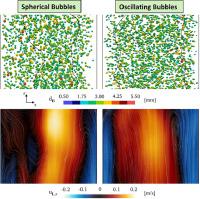当前位置:
X-MOL 学术
›
Int. J. Multiphase Flow
›
论文详情
Our official English website, www.x-mol.net, welcomes your
feedback! (Note: you will need to create a separate account there.)
On the force competition in bubble columns: A numerical study
International Journal of Multiphase Flow ( IF 3.6 ) Pub Date : 2020-07-01 , DOI: 10.1016/j.ijmultiphaseflow.2020.103256 Marcelo Muniz , Martin Sommerfeld
International Journal of Multiphase Flow ( IF 3.6 ) Pub Date : 2020-07-01 , DOI: 10.1016/j.ijmultiphaseflow.2020.103256 Marcelo Muniz , Martin Sommerfeld

|
Abstract Computational Fluid Dynamics (CFD) is nowadays fully accepted in engineering practice as a potential tool for the prediction of flows, conversion rates and process efficiency. The Euler/Lagrange is one of the available approaches for describing dispersed multiphase systems, for example in bubble columns. Hence, the flow field within the bubble column is computed using large eddy simulations (LES) considering full coupling with the bubble phase through momentum source terms as well as sub-grid-scale (SGS) turbulence modification by modelling bubble induced turbulence (BIT). Despite the required point-particle approximation, necessary for computing large-scale technical and industrial systems, bubble dynamics was included in the numerical modelling, through shape (eccentricity) and trajectory oscillations. The performance of the proposed bubble dynamics model is analysed in detail and it is shown that without a bubble dynamics model the bubble fluctuating velocities cannot be predicted correctly. In order to predict the bubble motion accurately it is necessary to account for all relevant acting forces in the calculations, namely, gravity/buoyancy, drag, transverse lift, added (virtual) mass, fluid inertia (part of the pressure term), Basset (history term) force and possibly modifications of these forces due to the presence of walls. Based on the state-of-the-art, instantaneous resistance coefficients for all these forces were elaborated and extended for allowing consideration of the bubble dynamic behaviour and deformation through the eccentricity. The proposed resistance coefficients do not consider any swarm effects and are therefore only applicable to bubbly systems with volume fractions of less than 5%. For the beginning clean systems with mobile bubbles are considered only which are moving in low-viscous systems such as a water-air two phase flows with small bubble Morton numbers. Most important, a lift force coefficient which is valid for such low viscous systems is applied based on recent studies. Consequently, a comprehensive and complete model is introduced for describing bubble motion in a point-particle approximation including bubble dynamics (eccentricity) and therefore using composite formulations especially for drag and transverse lift, and in addition accounting for added mass with bubble deformation and wall effects as well as the Basset force. For the regime of deformable bubbles, the resulting instantaneous resistance coefficients are extracted from bubble column simulations and compared with the mean resistance coefficients. Moreover, the local importance of all considered forces on the motion of bubbles within the bubble column was evaluated in detail in terms of bubble size, column height, radial position and Stokes number without and with bubble dynamics model. The importance of these forces and the correspondent effects on the velocity and volume fraction profiles are explored for a laboratory-scale bubble column. The influence of the bubble dynamics model and the considered interfacial forces on the predicted hydrodynamics of the laboratory bubble column is analysed for validation considering two cases with different bubble size distributions with sizes smaller than about 5 mm. Furthermore, the effect of Basset term on particle dispersion is highlighted in a turbulent pipe flow test case.
中文翻译:

关于气泡柱中的力竞争:数值研究
摘要 计算流体动力学 (CFD) 如今已被工程实践完全接受,作为预测流量、转化率和过程效率的潜在工具。Euler/Lagrange 是描述分散多相系统的可用方法之一,例如在气泡塔中。因此,气泡柱内的流场是使用大涡模拟 (LES) 计算的,考虑到通过动量源项与气泡相位的完全耦合以及通过对气泡诱导湍流 (BIT) 建模的亚网格尺度 (SGS) 湍流修正. 尽管需要计算大规模技术和工业系统所必需的点粒子近似,但通过形状(偏心率)和轨迹振荡,气泡动力学被包含在数值建模中。详细分析了所提出的气泡动力学模型的性能,结果表明,如果没有气泡动力学模型,就无法正确预测气泡波动速度。为了准确预测气泡运动,有必要在计算中考虑所有相关的作用力,即重力/浮力、阻力、横向升力、附加(虚拟)质量、流体惯性(压力项的一部分)、巴塞特(历史术语)力以及由于墙壁的存在而可能对这些力进行的修改。基于最先进的技术,对所有这些力的瞬时阻力系数进行了阐述和扩展,以便考虑气泡的动态行为和偏心引起的变形。建议的阻力系数不考虑任何群效应,因此仅适用于体积分数小于 5% 的气泡系统。对于刚开始的具有流动气泡的清洁系统,仅考虑在低粘度系统中移动的系统,例如具有小气泡莫顿数的水-空气两相流。最重要的是,基于最近的研究应用了适用于这种低粘性系统的升力系数。因此,引入了一个全面而完整的模型来描述气泡运动的点粒子近似,包括气泡动力学(偏心率),因此使用复合公式,特别是阻力和横向升力,此外还考虑了气泡变形和壁效应的附加质量以及巴塞特力。对于可变形气泡的状态,从气泡柱模拟中提取所得瞬时阻力系数并与平均阻力系数进行比较。此外,在没有和有气泡动力学模型的情况下,根据气泡大小、柱高、径向位置和斯托克斯数详细评估了所有考虑的力对气泡柱内气泡运动的局部重要性。这些力的重要性以及对速度和体积分数分布的相应影响在实验室规模的气泡柱中进行了探索。分析气泡动力学模型和所考虑的界面力对实验室气泡柱的预测流体动力学的影响以进行验证,考虑到尺寸小于约 5 mm 的不同气泡尺寸分布的两种情况。
更新日期:2020-07-01
中文翻译:

关于气泡柱中的力竞争:数值研究
摘要 计算流体动力学 (CFD) 如今已被工程实践完全接受,作为预测流量、转化率和过程效率的潜在工具。Euler/Lagrange 是描述分散多相系统的可用方法之一,例如在气泡塔中。因此,气泡柱内的流场是使用大涡模拟 (LES) 计算的,考虑到通过动量源项与气泡相位的完全耦合以及通过对气泡诱导湍流 (BIT) 建模的亚网格尺度 (SGS) 湍流修正. 尽管需要计算大规模技术和工业系统所必需的点粒子近似,但通过形状(偏心率)和轨迹振荡,气泡动力学被包含在数值建模中。详细分析了所提出的气泡动力学模型的性能,结果表明,如果没有气泡动力学模型,就无法正确预测气泡波动速度。为了准确预测气泡运动,有必要在计算中考虑所有相关的作用力,即重力/浮力、阻力、横向升力、附加(虚拟)质量、流体惯性(压力项的一部分)、巴塞特(历史术语)力以及由于墙壁的存在而可能对这些力进行的修改。基于最先进的技术,对所有这些力的瞬时阻力系数进行了阐述和扩展,以便考虑气泡的动态行为和偏心引起的变形。建议的阻力系数不考虑任何群效应,因此仅适用于体积分数小于 5% 的气泡系统。对于刚开始的具有流动气泡的清洁系统,仅考虑在低粘度系统中移动的系统,例如具有小气泡莫顿数的水-空气两相流。最重要的是,基于最近的研究应用了适用于这种低粘性系统的升力系数。因此,引入了一个全面而完整的模型来描述气泡运动的点粒子近似,包括气泡动力学(偏心率),因此使用复合公式,特别是阻力和横向升力,此外还考虑了气泡变形和壁效应的附加质量以及巴塞特力。对于可变形气泡的状态,从气泡柱模拟中提取所得瞬时阻力系数并与平均阻力系数进行比较。此外,在没有和有气泡动力学模型的情况下,根据气泡大小、柱高、径向位置和斯托克斯数详细评估了所有考虑的力对气泡柱内气泡运动的局部重要性。这些力的重要性以及对速度和体积分数分布的相应影响在实验室规模的气泡柱中进行了探索。分析气泡动力学模型和所考虑的界面力对实验室气泡柱的预测流体动力学的影响以进行验证,考虑到尺寸小于约 5 mm 的不同气泡尺寸分布的两种情况。











































 京公网安备 11010802027423号
京公网安备 11010802027423号